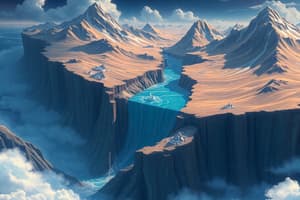Podcast
Questions and Answers
Which of the following processes commonly occur along plate boundaries?
Which of the following processes commonly occur along plate boundaries?
- Glacial melting, river erosion, and sedimentation
- Weathering, erosion, and deposition
- Volcanic eruptions, earthquakes, and mountain formation (correct)
- Hurricanes, tornadoes, and tsunamis
What are the main geological features associated with plate boundaries?
What are the main geological features associated with plate boundaries?
- Canyons, deltas, and caves
- Rift valleys, trenches, and ridges (correct)
- Valleys, lakes, and springs
- Deserts, plains, and plateaus
Which of the following is NOT a type of plate boundary?
Which of the following is NOT a type of plate boundary?
- Intrusive boundary (correct)
- Divergent boundary
- Transform boundary
- Convergent boundary
Which of the following is NOT a process that commonly occurs along plate boundaries?
Which of the following is NOT a process that commonly occurs along plate boundaries?
What process is responsible for the formation of mid-ocean ridges?
What process is responsible for the formation of mid-ocean ridges?
Which of the following processes is associated with the formation of mountain ranges?
Which of the following processes is associated with the formation of mountain ranges?
Flashcards
Common Plate Boundary Processes?
Common Plate Boundary Processes?
Volcanic eruptions, earthquakes, and mountain formation.
Geological Features of Plate Boundaries?
Geological Features of Plate Boundaries?
Rift valleys, trenches, and ridges.
Mid-Ocean Ridge Formation?
Mid-Ocean Ridge Formation?
The creation of new oceanic crust at mid-ocean ridges where plates are moving apart.
Subduction and Mountain Ranges?
Subduction and Mountain Ranges?
Signup and view all the flashcards
Study Notes
Plate Boundaries Processes
- Subduction, seafloor spreading, and transform faulting are common processes along plate boundaries.
- Earthquakes often occur due to the sudden movement of tectonic plates at these boundaries.
Geological Features at Plate Boundaries
- Mid-ocean ridges are formed where tectonic plates are diverging.
- Trenches result from subduction, where one plate moves beneath another.
- Mountain ranges are commonly found at convergent boundaries where plates collide.
Types of Plate Boundaries
- Divergent, convergent, and transform faults are recognized types of plate boundaries.
- Any option that does not fit into these categories is NOT a type of plate boundary.
Non-Associated Processes
- Processes that do not typically occur along plate boundaries include weathering or erosion, which are driven by surface conditions rather than tectonic activity.
Mid-Ocean Ridge Formation
- Mid-ocean ridges are formed primarily through the process of seafloor spreading, where magma rises to create new oceanic crust as tectonic plates pull apart.
Mountain Range Formation Process
- The collision of tectonic plates at convergent boundaries leads to the formation of mountain ranges, as the Earth's crust is pushed upwards.
Studying That Suits You
Use AI to generate personalized quizzes and flashcards to suit your learning preferences.




